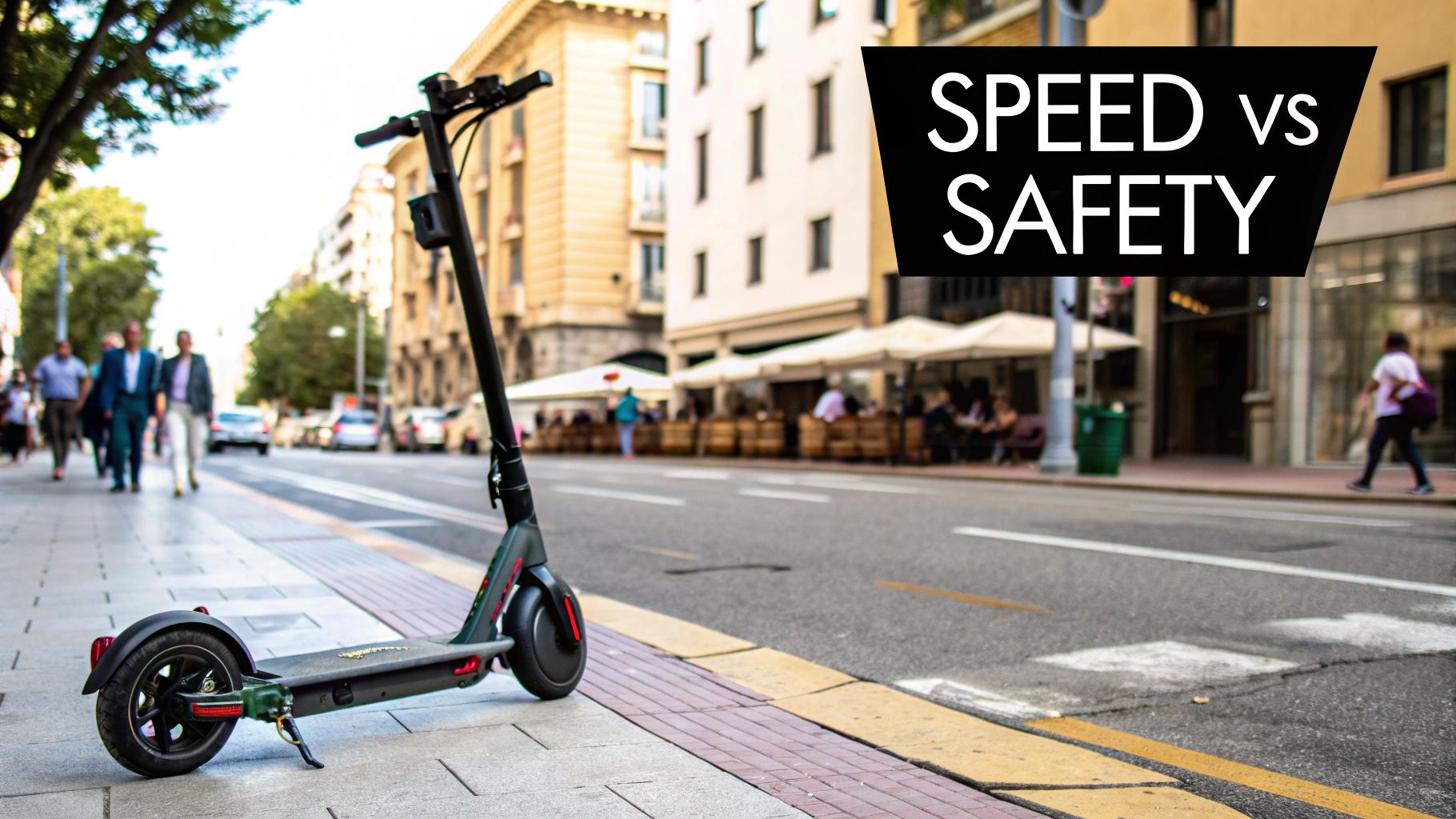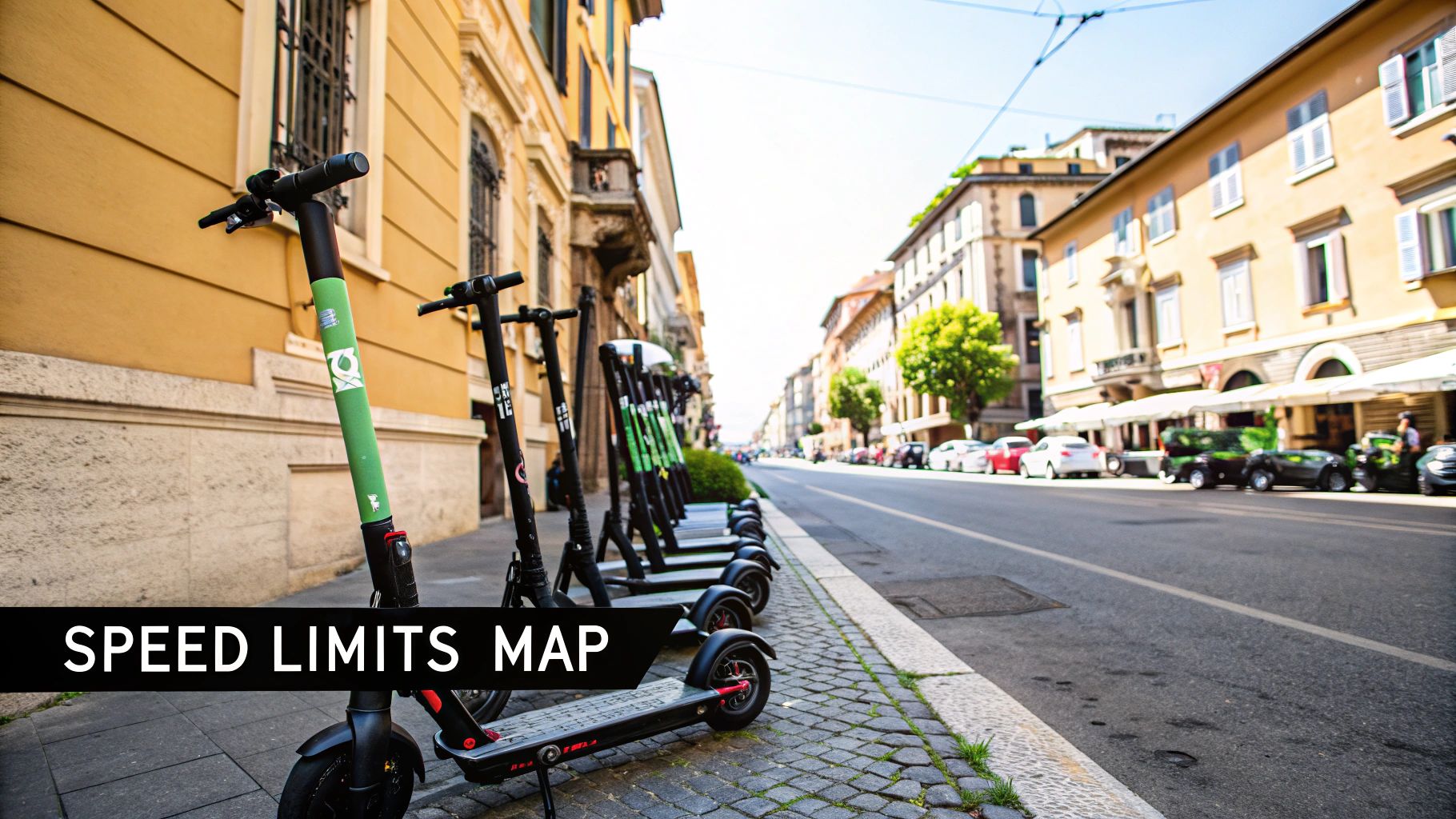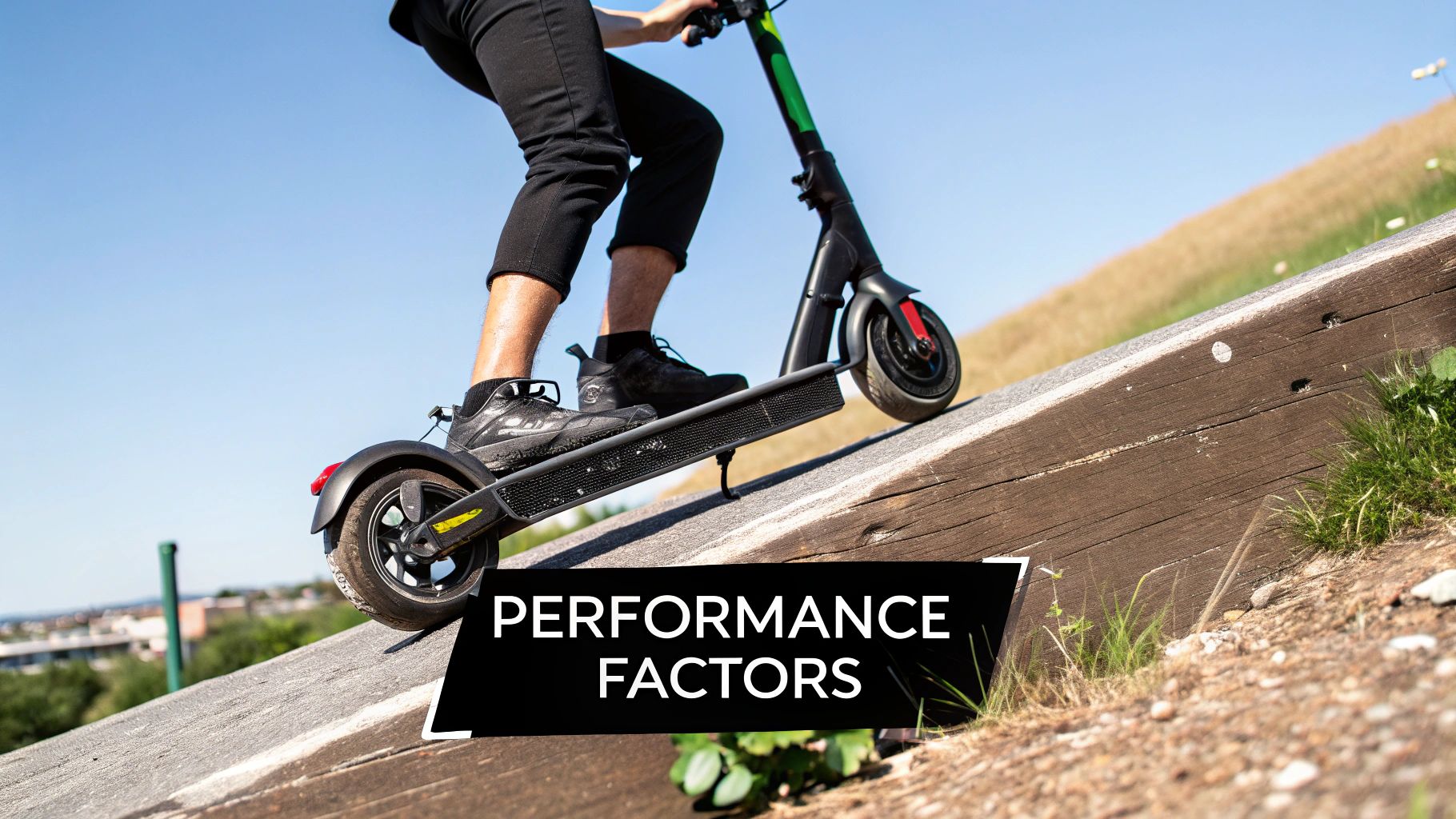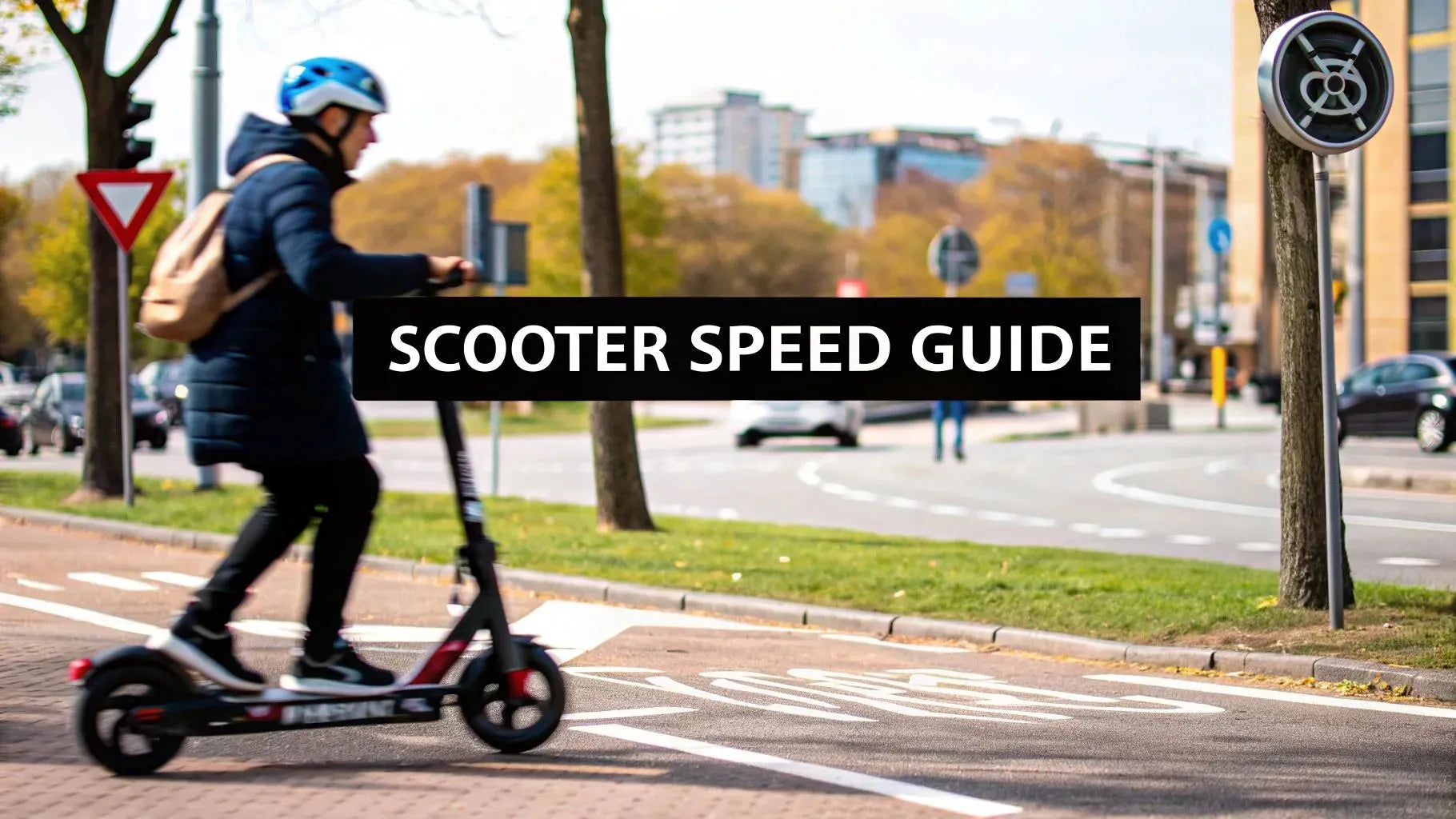Figuring out the electric scooter speed limit can feel like trying to hit a moving target. In many places like the UK and Europe, regulators are starting to agree on a standard speed, often around 15.5 mph (25 km/h). But in countries like the United States and Australia, it's a completely different story. There, the rules can change dramatically just by crossing a state line or even a city limit.
This guide is designed to cut through the confusion. We'll explore why these speed limits exist, how the laws in the US and Australia create a unique and complex landscape for riders, and what factors in the real world will ultimately determine how fast you can actually go.
Your Quick Guide to E-Scooter Speeds
Trying to navigate e-scooter speed limits can be confusing. The rules don't just change from country to country; they often vary from state to state or even city to city. But there's a good reason for all this regulation: safety. Setting clear, predictable speed limits is the best way to protect everyone sharing the road and pavement.
If you're looking for a global benchmark, 15.5 mph (25 km/h) is a common figure you'll see in many parts of Europe. However, in the US and Australia, the picture is far more fragmented, with local governments setting their own standards based on their unique traffic and safety needs.
Private vs. Rental Scooters
One of the biggest trip-ups for new riders is the difference in rules for privately owned scooters versus the shared ones you rent through an app. Rental scooters, operated by companies like Lime or Bird, almost always come with built-in speed limiters and geofencing technology. This means the scooter's top speed is automatically capped to comply with local laws.
Privately owned scooters, on the other hand, often have the technical capability to go much faster. However, as a rider, you are legally responsible for knowing and adhering to the local electric scooter speed limit, regardless of what your scooter can do.
The bottom line is this: rental scooters are designed to automatically follow the law, while private scooter owners must take on the responsibility of riding within legal speed limits themselves.
This handy infographic gives you a quick look at the typical speed limits across some key regions.
As you can see, while there's some convergence around 15.5 mph (25 km/h), places like Australia show significant variation, with some states capping speeds as low as 6 mph (10 km/h). If you're planning to ride, getting to know these local differences is a must.
Here’s a quick table to make sense of the key differences between the US, Australia, and the general approach in the EU.
E-Scooter Rules US vs. Australia vs. EU at a Glance
| Aspect | United States (Varies by State/City) | Australia (Varies by State/Territory) | European Union (General Consensus) |
|---|---|---|---|
| Legal Status | Legal in most states, but specific rules are set at the state or city level. | Legal, but heavily regulated at the state and territory level with significant variations. | Generally legal for both private and rental scooters, though specific laws vary by country. |
| Typical Speed Limit | Often 15-20 mph (24-32 km/h), but many major cities cap it at 15 mph. | Varies widely, from 10 km/h (6 mph) in NSW to 25 km/h (15.5 mph) in Queensland. | Varies, but commonly 15.5 mph (25 km/h). Some countries are lower (e.g., Germany at 12.4 mph). |
| Where to Ride | Typically bike lanes and roads. Sidewalk riding rules vary immensely by city. | Varies by state; some allow footpath riding, others restrict scooters to bike paths and roads. | Primarily cycle lanes and roads. Pavement riding is almost always prohibited. |
| Rider Requirements | Varies. Some states require a driver's license, others have minimum age requirements (often 16 or 18). | Varies by state. Minimum age is common, but license requirements differ. | Varies widely. Some countries have no licence requirement but may enforce a minimum age (often 14 or 16). |
This table highlights the fragmented nature of regulations in the US and Australia compared to the more harmonized, albeit still varied, approach seen across Europe.
Why Speed Limits Are More Than Just Numbers

Ever wondered why so many electric scooter speed limits land somewhere between 15 and 20 mph? It might seem like lawmakers just picked a number out of a hat, but there's actually a good bit of safety science behind it.
It all boils down to a basic physics principle: kinetic energy.
Picture this: catching a baseball tossed gently from a few feet away is no big deal. But if a pro pitcher hurled that same ball at you? The impact would be worlds apart. The ball's weight didn't change, but its speed did—and that's everything.
Kinetic energy doesn't just go up with speed; it skyrockets. Doubling your speed from 10 mph to 20 mph doesn't double the impact force, it quadruples it. A tiny bump in speed can be the difference between a minor spill and a life-changing accident.
Balancing Speed with Safety
Regulators and city planners have a tough job. They need to find that perfect sweet spot where e-scooters are fast enough to be useful for getting around, but not so fast that they become a major risk to riders and everyone else on the sidewalk.
To strike this balance, they look at a few crucial things that affect how well a rider can handle an unexpected obstacle.
These key factors include:
- Reaction Time: This is the split-second it takes for your brain to see a hazard—like a pedestrian stepping off the curb—and tell your hands to hit the brakes.
- Braking Distance: This is the actual ground you cover from the moment you squeeze the brakes until you come to a dead stop.
- Impact Force: This is the energy released in a crash, which is directly tied to how severe the injuries will be.
Turns out, 15 mph (24 km/h) is widely seen as a solid compromise. It’s quick enough to make your commute feel zippy, but it keeps your braking distance in a manageable zone and dramatically lowers the odds of a truly devastating injury if a collision does happen.
Once you get the physics, it’s clear that speed limits aren’t just about making you follow the rules. They’re a safety net, designed to keep the scooter’s energy at a level where you can stay in control and the consequences of a crash are far less severe.
The Proof Is in the Data
This isn't just theory, either. We have real-world data showing that these speed limits work. Studies on e-scooter speed restrictions consistently show they lead to fewer injuries.
For example, a 2022 study looked at cities that capped speeds at 20 km/h during the day and an even slower 15 km/h at night. The results were pretty dramatic. In Helsinki, the injury rate dropped from 19 injuries down to just 9 per 100,000 trips after they brought in the new limits. If you want to dive deeper, you can explore more of these e-scooter injury findings and see the impact for yourself.
Navigating E-Scooter Laws in the US and Australia

While Europe moves towards standardization, riding an e-scooter in the United States or Australia requires a hyper-local awareness. There's no single rulebook. Instead, you're dealing with a patchwork quilt of laws, and what’s perfectly legal in one state could get you in hot water in the next.
This fragmented approach shows just how challenging it is for governments to adapt traditional traffic laws to modern micro-mobility.
The United States: A State-by-State Puzzle
In the US, there's no single, federal law that dictates the electric scooter speed limit. It’s a mosaic of state and local rules. This means a rider in Los Angeles operates under a different set of speed and usage laws than someone in New York City or Austin, Texas.
A common speed cap you'll find in many major US cities is 15 mph (24 km/h).
Here's a quick look at what you can expect in a few key states:
- California: As a trendsetter in micro-mobility, California sets a statewide speed limit of 15 mph (24 km/h) for e-scooters. Riders are also generally required to have a driver's license and wear a helmet.
- New York: In NYC, the speed limit is also capped at 15 mph. E-scooters are permitted in bike lanes and on streets with speed limits of 30 mph or less, but sidewalk riding is strictly forbidden.
- Florida: Florida is a bit more permissive, allowing e-scooters to travel up to 20 mph (32 km/h), though local municipalities can impose lower limits. They are generally treated like bicycles, meaning they can be ridden in bike lanes.
For a deeper dive, you can find more details on how these state-level speed caps work and check out the specific rules for major cities.
Australia: A Tale of Two Speeds
Down under, Australia's system is just as fragmented, with each state and territory setting its own distinct rules. The difference in speed limits from one state to the next can be staggering, making it crucial for riders to know the local law.
The debate often centers on finding a balance between enabling efficient travel and ensuring pedestrian safety on shared paths.
Here are some examples of the wide-ranging rules:
- Queensland (QLD): This state is one of the more progressive, allowing e-scooters a top speed of 25 km/h (15.5 mph) on most bicycle paths, footpaths, and local roads.
- Victoria (VIC) and New South Wales (NSW): These states have taken a far more cautious approach. In many areas, privately owned e-scooters are either heavily restricted or limited to a speed of just 10 km/h (about 6 mph) on public paths.
The massive gap between Queensland's 25 km/h and Victoria's 10 km/h really highlights how different governments are trying to find the right balance between convenience and safety. One values getting around quickly, while the other puts protecting pedestrians first.
This variation can be a real headache for riders. It’s why it is absolutely essential to check the specific regulations for the state and city you'll be riding in before you head out. Knowing the lay of the land is your first step to riding safely and legally. Before you pull the trigger on a new scooter, make sure you're up to speed on the rules in your area. Our in-depth electric scooter buying guide can help you pick a model that's a perfect fit for both you and your local laws.
What Really Affects Your Top Speed in the Real World

Let's be real for a second. The speed you see printed on the box is a "best-case scenario" number, achieved in a lab under perfect conditions. Out on the street, though, things are a lot different. Legal speed limits are one thing, but your scooter's actual performance has a mind of its own.
Think of it this way: your scooter's motor is like an Olympic sprinter. On a perfectly flat track with no wind and a good night's sleep, they're going to set a personal best. But ask that same sprinter to run up a hill, into a headwind, after a long day? You'll see a totally different result. Your scooter is no different.
The Big Three Speed Killers
Your scooter is in a constant fight against forces trying to slow it down. Knowing what they are helps you figure out what to expect from your ride and how to get the most out of your machine. The most common culprits are your own weight, the hills you're tackling, and even your battery level.
These factors all gang up to decide whether you're hitting that advertised top speed or falling a bit short.
- Rider Weight: This is just straight-up physics. The heavier the load, the more energy it takes to get it moving and keep it there. Most manufacturers test their scooters with a rider who weighs around 75 kg (165 lbs). If you're heavier than that, expect a dip in your top speed and how quickly you get there.
- Terrain and Hills: A steep hill is the ultimate villain for your scooter's motor. When you start climbing, the motor has to work overtime, shifting power from maintaining speed to just producing enough grunt to get you up the incline. Even a long, gradual slope will slowly but surely chip away at your max speed.
- Tire Pressure: This is the one everyone forgets. Underinflated tires get squishy and create way more friction with the road—what's known as rolling resistance. This extra drag forces the motor to work harder just to keep you moving, which saps power and slows you down.
Your Battery Is Your Gas Tank
The charge level of your e-scooter's battery is probably one of the biggest factors affecting how fast you can go. It’s not just about how long you can ride; it's about how fast you can ride during that time.
A fully charged battery gives the motor the maximum voltage, letting it spin as fast as possible and giving you that awesome, snappy acceleration. But as the battery drains, the voltage drops. Less voltage means less power for the motor, which translates to a gradual decrease in your top speed. You'll really start to feel this slowdown once your battery dips below the 50% mark.
Think of your battery gauge as a power meter, not just a fuel gauge. A full battery unlocks your scooter's true potential. A low battery forces it into a self-preservation mode, trading top-end speed for a little more range.
This is exactly why your scooter always feels its fastest and most responsive right at the start of a ride. If you know you'll be dealing with hills or long commutes, it's worth looking at models built for the job. Check out our guide to the best electric scooters for adults to find a machine with the power and battery to match your needs.
How to Ride Safely and Stay Within the Law
https://www.youtube.com/embed/EHnErMI8Cgg
Knowing the speed limit for your electric scooter is one thing, but riding safely is a whole different ball game. It’s all about creating smart habits that keep you, and everyone around you, safe. You have to treat your e-scooter with the same respect you'd give a car or a bike.
Let's be real—riding safe isn't just about dodging a ticket. It's about making sure a fun trip doesn't end with a trip to the emergency room. A few simple actions can make a world of difference.
Your Essential Pre-Ride Checklist
Before you even hop on, take a minute for a quick safety check. Think of it like a pilot's pre-flight inspection; it's a small habit that can prevent big problems down the road.
- Brake Check: Give the brake levers a good squeeze. They should feel firm and responsive, not squishy. You need to know you can stop on a dime.
- Tyre Inspection: Glance at your tyres and give them a press. Good tyre pressure means better grip, a smoother ride, and more stability.
- Lights On: Planning to ride when it’s dark out? Make sure your front and rear lights actually work. Being seen is everything.
- Helmet On, Always: This one’s a no-brainer. Strap on a properly fitted helmet. For riders under 18, it's often the law, but honestly, it’s a smart move for everyone.
Think Twice Before Modifying Your Scooter
I get it, the temptation to "chip" your scooter to unlock more speed is real. But messing with the factory speed limiter is a seriously bad idea. These machines are engineered to be safe up to a certain speed—the frame, the brakes, the tyres, none of it is built to handle race-track velocities.
Pushing your scooter past its designed speed limit doesn't just void your warranty; it's a recipe for disaster. The brakes might fail, or the frame itself could buckle under the stress when you need it most.
And if you get caught riding a souped-up scooter on public roads? The penalties can be harsh. We're talking hefty fines, points on your driver's licence, and they might even confiscate your ride. It’s just not worth it.
If you're just starting out, mastering the basics is far more important than raw speed. For more tips, check out our guide on how to ride an electric scooter.
Got questions about e-scooter speeds? Good. It's a confusing topic, and you're definitely not the only one trying to make sense of it all. Let's break down some of the most common questions and get you some clear, simple answers.
What Is a Common E-Scooter Speed Limit in the US?
There is no single federal speed limit, but a common cap in many states and major cities like New York and Los Angeles is 15 mph (24 km/h). However, some states like Florida allow up to 20 mph. You must always check the local city and state regulations where you intend to ride.
Can I Get Fined for Speeding on an E-Scooter?
You absolutely can. If you get caught exceeding the local speed limit on an e-scooter, you can face significant fines. In some jurisdictions, you could even receive points on your driver's license or have your scooter impounded. The rules are enforced just like any other traffic violation.
Why Are Rental Scooter Speeds Different in Certain Areas?
It all comes down to geofencing technology. Rental companies use GPS to create virtual boundaries that automatically control the scooter's speed based on its location.
For example, when you ride through a busy park or a crowded downtown area, the scooter might automatically slow down to a safer 8-10 mph. The standard top speed (e.g., 15 mph) is typically reserved for streets and bike lanes where you can safely mix with other traffic. It's a smart safety feature that adapts the scooter's performance to its environment.
Ready to find a ride that matches your local rules and your style? Punk Ride LLC offers a curated selection of top-brand electric scooters and bikes to get you moving. Explore our collection and find your perfect match today.





Share:
Boost Your Electric Bike Battery Life
8 Essential Electric Scooter Safety Tips for 2025